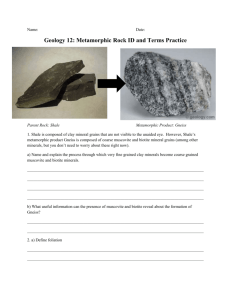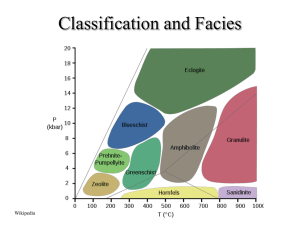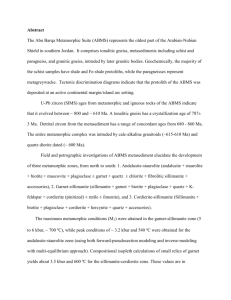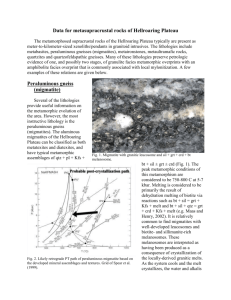JS_pelitic_lab
advertisement
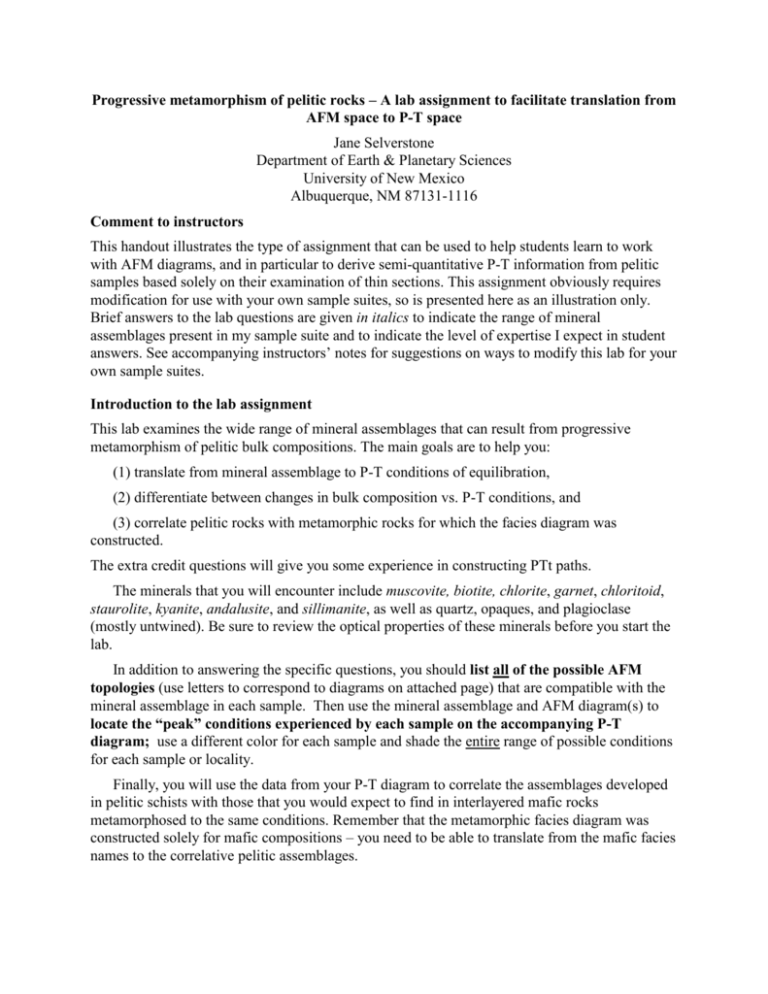
Progressive metamorphism of pelitic rocks – A lab assignment to facilitate translation from AFM space to P-T space Jane Selverstone Department of Earth & Planetary Sciences University of New Mexico Albuquerque, NM 87131-1116 Comment to instructors This handout illustrates the type of assignment that can be used to help students learn to work with AFM diagrams, and in particular to derive semi-quantitative P-T information from pelitic samples based solely on their examination of thin sections. This assignment obviously requires modification for use with your own sample suites, so is presented here as an illustration only. Brief answers to the lab questions are given in italics to indicate the range of mineral assemblages present in my sample suite and to indicate the level of expertise I expect in student answers. See accompanying instructors’ notes for suggestions on ways to modify this lab for your own sample suites. Introduction to the lab assignment This lab examines the wide range of mineral assemblages that can result from progressive metamorphism of pelitic bulk compositions. The main goals are to help you: (1) translate from mineral assemblage to P-T conditions of equilibration, (2) differentiate between changes in bulk composition vs. P-T conditions, and (3) correlate pelitic rocks with metamorphic rocks for which the facies diagram was constructed. The extra credit questions will give you some experience in constructing PTt paths. The minerals that you will encounter include muscovite, biotite, chlorite, garnet, chloritoid, staurolite, kyanite, andalusite, and sillimanite, as well as quartz, opaques, and plagioclase (mostly untwined). Be sure to review the optical properties of these minerals before you start the lab. In addition to answering the specific questions, you should list all of the possible AFM topologies (use letters to correspond to diagrams on attached page) that are compatible with the mineral assemblage in each sample. Then use the mineral assemblage and AFM diagram(s) to locate the “peak” conditions experienced by each sample on the accompanying P-T diagram; use a different color for each sample and shade the entire range of possible conditions for each sample or locality. Finally, you will use the data from your P-T diagram to correlate the assemblages developed in pelitic schists with those that you would expect to find in interlayered mafic rocks metamorphosed to the same conditions. Remember that the metamorphic facies diagram was constructed solely for mafic compositions – you need to be able to translate from the mafic facies names to the correlative pelitic assemblages. 1) Samples from the Devonian Acadian orogeny, New England (+ one Precambrian sample from margin of Adirondack Mountains). Any minerals that you think are retrograde should be labeled “R”; minerals present only as inclusions in garnet should be labeled “I”. Sample Assemblage (all include quartz and opaques) AFMs NE87-15 (Adirondack margin - pC) Garnet biotite sillimanite K-feldspar S NE87-42 (Pinney Hollow fm, E of Green Mtns, VT) NE87-63 (Gassetts schist, Chester Dome, VT) NE89-9 (Clough fm, near Keene, NH) Chlorite chloritoid muscovite B-C-D-E-F-G-H-I Garnet biotite staurolite chlorite-I,R chloritoid-I muscovite Inclusions: H-I Garnet biotite sillimanite muscovite P-Q-R BF-2 (Partridge fm, Walpole, NH) Garnet biotite chlorite muscovite H-I-J Peak: K-L-M-N-O Muscovite pseudomorphs after andalusite If you ignore most of the complexities and consider only NE87-42, NE87-63, and NE89-9, what generalization can you make about the currently exposed metamorphic grade along a NNW-toSSE transect across Vermont and into New Hampshire? Metamorphic grade increases from greenschist facies in the NNW to middle amphibolite facies in the SSE. (My students would have maps available in the lab room to see the geographic distribution of samples, and also of isograds. 2) Samples from the 1.4 Ga contact aureole of the Sandia Pluton near Albuquerque, NM Pay particular attention to the Al2SiO5 minerals in these samples; they will help you to figure out the relative positions of these three samples in the field, and also on the P-T diagram. Notice that one of these samples contains two coexisting Al2SiO5 minerals. SAN-1: Biotite Andalusite Sillimanite muscovite SAN-2: Biotite Andalusite Muscovite SAN-3: Biotite Sillimanite Muscovite AFMs: L-R on or near sill-and reaction boundary AFMs: L-R in andalusite field AFMs: L-R in sillimanite field (a) Use the mineral assemblages to place the three samples in relative order of distance from the pluton. Closest to pluton: SAN-3: sillimanite represents the highest T Intermediate: SAN-1: coexisting and+sill represents intermediate T Farthest from pluton: SAN-2: andalusite represents lowest T (b) Why is there no garnet in any of these three samples? The rocks are too magnesian. Garnet is stable at the P-T conditions represented by these three rocks, but only in Fe-rich rocks. These rocks all lie on Al2SiO5-biotite tielines on the AFM diagrams, and hence cannot “see” garnet. (c) Approximately how deep were these rocks when they were intruded by the Sandia Pluton at 1.4 Ga? All three samples were collected in close proximity to one another, so we can assume that they record roughly the same depth of burial. The constraint on this depth then comes from sample SAN-1, which equilibrated on or near the And-Sill reaction boundary, in fields L through R on the attached P-T grid (see AFM diagrams too). The pressure of equilibration was thus ~2.2-3.0 kbar. Using an average conversion factor of 1 kbar = 3.5 km of overburden yields a depth of emplacement of approximately 7-11 km for the Sandia Pluton. 3) Samples from the Tertiary Alpine orogeny, Eastern Alps: K93-28A, Z2-P, and Q4-A. These three samples were collected within 300 m of each other and presumably all experienced the same pressure-temperature history. K93-28A is a metamorphosed soil! K93-28A: Staurolite Chloritoid Chlorite Muscovite Z2-P: Kyanite Chlorite Staurolite Chloritoid Muscovite Q4-A: Garnet Biotite Chlorite muscovite AFMs: F-G-H-I AFMs: E-F-G-H-I AFMs: H-I-J (b) If the Alpine samples all equilibrated at the same P&T, why do the mineral assemblages differ? The samples represent different bulk compositions, as is evident from examination of the AFM diagrams. (c) Sample Z2-P contains too many minerals to be divariant on an AFM diagram. Please list and assess at least three possible explanations for why it contains so many AFM minerals. 1. Chlorite could be retrograde. However, it is not obviously replacing either chloritoid or staurolite, so this interpretation is unlikely. 2. There could be an extra chemical component in the rock that is not taken into account in construction of the AFM diagram. For this assemblage, the most likely culprit would be ZnO in staurolite. There is no way to assess this quantitatively without microprobe data, but this would be a reasonable interpretation if all four AFM minerals were in close proximity and were reasonably euhedral – which is not the case. 3. Not all minerals belong to the same generation. Kyanite contains randomly oriented opaque inclusions and is broken and kinked, i.e. pre- to syn-kinematic. Staurolite and chloritoid are aligned in the foliation and look syn-kinematic. Some chlorite is in the foliation but most crosses the foliation – it is thus syn- to post-kinematic. We may be seeing a switch here from kya-staur-ctd to staur-ctd-chl, i.e. the univariant reaction kya + ctd = chl + staur. If this is the case, the stable assemblage is really staur-ctd-chl and kyanite persists metastably. 4) For each of the samples listed below, list the prograde AFM minerals that are present. Then, based on the P-T conditions for each sample, list the minerals that you would expect to find in metabasalts interlayered with the pelitic samples. Finally, name the metamorphic facies (greenschist, amphibolite, etc.) in which “peak” thermal equilibration occurred. Sample “peak” AFM minerals Minerals in basaltic equivalent Facies NE87-42 Chl-Ctd-Musc Actinolite-Chlorite-Albite Greenschist K93-28A Staur-Ctd-Chl-Musc Actin/Hbl-Plag±Epid±Chl Greenschist to epid amphib Z2-P Staur-Ctd-Chl-Musc±Kya Actin/Hbl-Plag±Epid±Chl Greenschist to epid amphib Q4-A Gar-Bio-Chl-Musc Hornblende-Epidote-Plag Epidote amphibolite BF-2 Gar-Bio-Chl-Musc Hornblende-Epidote-Plag Epidote amphibolite SAN-2 Bio-And-Musc Hornblende-Plag Low-P Amphibolite SAN-1 Bio-And-Sill-Musc Hornblende-Plag Low-P Amphibolite SAN-3 Bio-Sill-Musc Hornblende-Plag Low-P Amphibolite NE87-63 Gar-Staur-Bio-Musc Hornblende-Plag±Garnet Amphibolite NE89-9 Gar-Bio-Sill-Musc Hornblende-Plag±Garnet Amphibolite NE87-15 Gar-Bio-Sill-Kspar Plag±Hbl±Gar±Cpx±Opx Granulite EXTRA CREDIT. Samples from Bellows Falls, Vermont: NE87-75 and BF-2. These two samples are from a major thrust structure associated with the Acadian orogeny in northern New England. NE87-75 is from the upper (overriding) plate, and BF-2 is from the lower plate. Both samples contain pseudomorphs after andalusite: be sure to list the mineralogy of these pseudomorphs now. Also, note that the muscovite in NE87-75 is all secondary and is not part of the “peak” assemblage that you plot on an AFM; there are also several other indicators of both prograde and retrograde reactions in this sample. Note also that kyanite is present at BF-2, though not in the sample that you have. (a) List the complete assemblages. Mark prograde minerals with a P and retrograde with R. NE87-75 matrix: Garnet Biotite Sillimanite K-feldspar Minor hercynite Retrograde muscovite Retrograde chlorite Retrograde staurolite Pseudomorphs: Sillimanite after andalusite BF-2 matrix: Garnet Biotite Chlorite Muscovite AFMs: Prograde = S Retrograde = K? (staur-chl-bio-musc) AFMs: H-I-J Pseudomorphs: Muscovite after andalusite (b) Plot the “peak” assemblage for each sample on the P-T grid and then construct semiquantitative P-T paths for as much of the history of each sample as you can. Why do you think that the paths are so different, when the two samples were collected very close to one another? BF-2 is in the lower plate of a nappe complex and experienced an increase in P when overriding nappes were emplaced. NE87-75 may initially have been buried by a higher nappe, then was transported ~ isobarically to position above BF-2. Cooling of NE87-75 likely reflects transport over cooler underlying rocks during thrusting. Initial heating in NE87-75 probably reflects proximity to pluton. (My students would have seen maps and cross sections of the area before answering this question).
